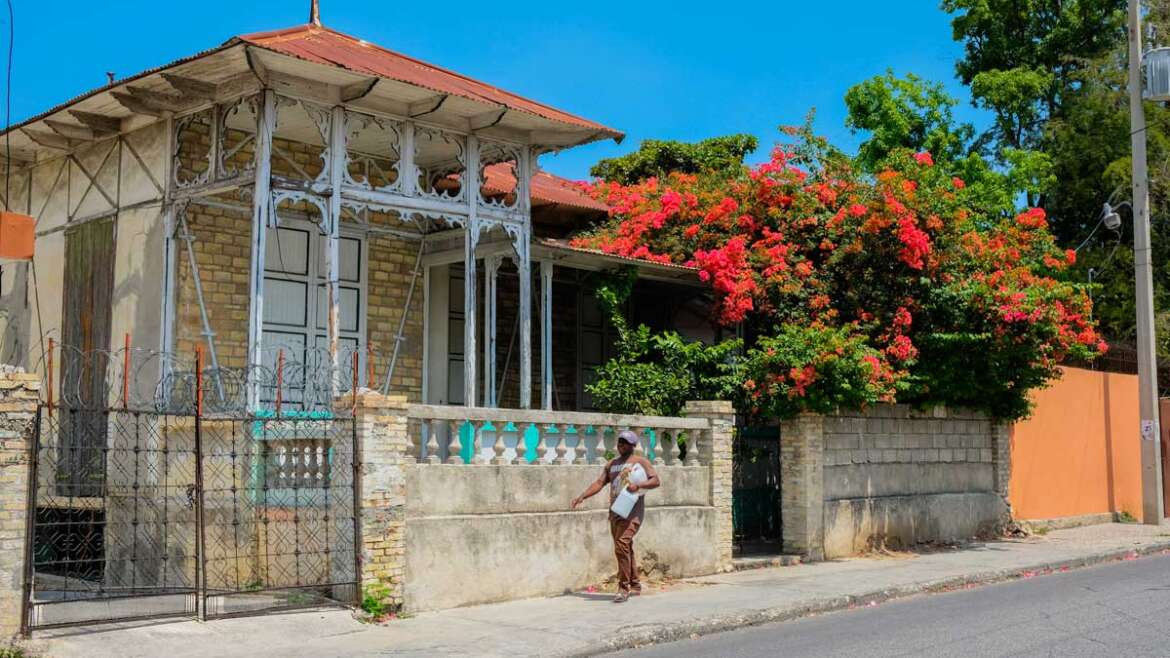"an important architectural and cultural heritage, not just for Haiti but also for the international community."
Gingerbread Houses are ornate turn-of-the-century buildings unique to Haiti. Like their edible namesake, Gingerbread Houses are famous for steep roofs and ornate details highlighted in vibrant, contrasting colours. They are architecturally fascinating for a number of reasons – not least because they’ve proven to be surprisingly resistant to earthquakes.
An iconic feature of urban communities around Haiti, these ageing architectural masterpieces have survived a century of turmoil and natural disaster, and are a compelling conservation opportunity. And they’ve just been formally recognised as one of the most important at-risk heritage sites in the world.
Where can you see Gingerbread Houses?
These stately relics are scattered throughout Port-au-Prince, but are concentrated in the neighborhoods of Pacot, Turgeau, Bois Verna, and Bas Peu de Choses. You’ll also find Gingerbread Houses in other cities around Haiti, including Jérémie, Jacmel, and Cap-Haïtien.
Who were they built for? What are they used for now?
Originally, Gingerbread Houses were built as the residences of powerful Haitian families, and many surviving examples have housed Haitian presidents. During the 1900s, some of these Gingerbread residences were acquired or built by Catholic institutions, which is why many of the Catholic schools and buildings you can see today are examples of the Gingerbread style.
During Haiti’s boom time as a fashionable travel destination in the 1950s and 60s (when the moniker “Gingerbread” was first introduced by American tourists), Gingerbread Houses were symbols of prestige, used as the seasonal residences of stars like Truman Capote, Noël Coward, Graham Greene and Katherine Dunham, who stayed at the Hotel Oloffson or bought Gingerbread Houses of their own.
Today, most of the investment in Gingerbread Houses comes from the arts. Organizations like Kolektif 509, FOKAL, Fondation Viviane Gauthier and Le Centre d’Art are restoring iconic Gingerbread Houses and opening them up to the public as spaces to preserve, practice and promote Haitian art forms.
Architectural style
In 1895, three young Haitians travelled to Paris to study architecture, and adapted Parisian architecture to the Caribbean climate and living conditions. Together, these young architects refined the architectural style now known as “Gingerbread”, designing civic buildings and residences that combined French-inspired, Victorian Gothic grandeur with flamboyant colors and vivid decorative patterns – including vèvè symbols from Haitian vodou.
Designed for Haiti’s tropical hot and humid weather, Gingerbread Houses feature tall ceilings, doors and windows as well as wrap-around verandahs, all decorated in a vibrant, distinctive style with elaborate details unique to Haiti. Most Gingerbread Houses were constructed using natural, flexible timber frames that have the innate ability to weather some of the Caribbean’s toughest storms (and as it turns out, even earthquakes).
Inside, they’re a mastery of climate-control, with high ceilings and tall turret roofs designed to draw hot air upwards and out of living rooms. Louvred shutter windows allow cool breezes in and keep moisture out. In the leafy suburbs of Pacot, Pétion-Ville and Turgeau, these majestic windows open out onto picturesque views of the city. Luxurious, extended front porches plunge onto stately grounds with manicured tropical gardens.
Conservation
By the 21st century, many of these once-elegant, century-old structures had fallen into disrepair. Although the communities of people living in and caring for Gingerbread Houses had made substantive efforts to preserve them, political and economic conditions meant that only some of these iconic buildings could be adequately preserved.
As a whole, the historic Gingerbread House district of Port-au-Prince wasn’t getting the support it needed as an at-risk cultural heritage site. In 2009, the Haitian Leadership and Education Program (HELP) successfully brought Gingerbread Houses to the attention of the World Monuments Fund (WMF), in the hopes of generating support for the restoration of these irreplaceable treasures. In late 2009, Haiti’s Gingerbread Houses were chosen as one of the WMF’s 2010 World Monuments Watch list.








